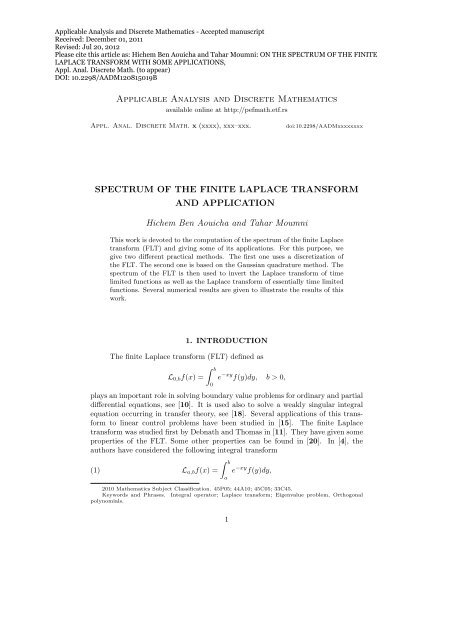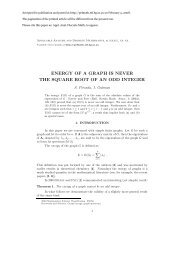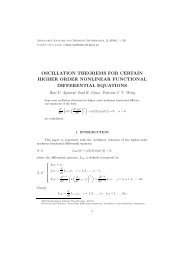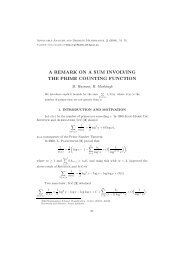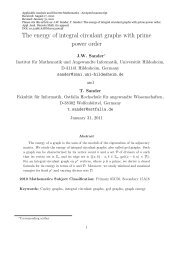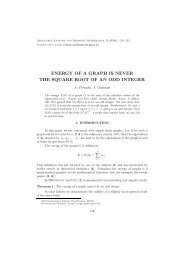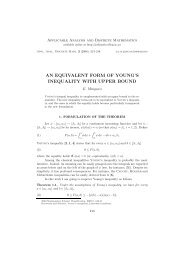Applicable Analysis and Discrete Mathematics SPECTRUM OF THE ...
Applicable Analysis and Discrete Mathematics SPECTRUM OF THE ...
Applicable Analysis and Discrete Mathematics SPECTRUM OF THE ...
You also want an ePaper? Increase the reach of your titles
YUMPU automatically turns print PDFs into web optimized ePapers that Google loves.
<strong>Applicable</strong> <strong>Analysis</strong> <strong>and</strong> <strong>Discrete</strong> <strong>Mathematics</strong> - Accepted manuscript<br />
Received: December 01, 2011<br />
Revised: Jul 20, 2012<br />
Please cite this article as: Hichem Ben Aouicha <strong>and</strong> Tahar Moumni: ON <strong>THE</strong> <strong>SPECTRUM</strong> <strong>OF</strong> <strong>THE</strong> FINITE<br />
LAPLACE TRANSFORM WITH SOME APPLICATIONS,<br />
Appl. Anal. <strong>Discrete</strong> Math. (to appear)<br />
DOI: 10.2298/AADM120815019B<br />
<strong>Applicable</strong> <strong>Analysis</strong> <strong>and</strong> <strong>Discrete</strong> <strong>Mathematics</strong><br />
available online at http://pefmath.etf.rs<br />
Appl. Anal. <strong>Discrete</strong> Math. x (xxxx), xxx–xxx.<br />
doi:10.2298/AADMxxxxxxxx<br />
<strong>SPECTRUM</strong> <strong>OF</strong> <strong>THE</strong> FINITE LAPLACE TRANSFORM<br />
AND APPLICATION<br />
Hichem Ben Aouicha <strong>and</strong> Tahar Moumni<br />
This work is devoted to the computation of the spectrum of the finite Laplace<br />
transform (FLT) <strong>and</strong> giving some of its applications. For this purpose, we<br />
give two different practical methods. The first one uses a discretization of<br />
the FLT. The second one is based on the Gaussian quadrature method. The<br />
spectrum of the FLT is then used to invert the Laplace transform of time<br />
limited functions as well as the Laplace transform of essentially time limited<br />
functions. Several numerical results are given to illustrate the results of this<br />
work.<br />
1. INTRODUCTION<br />
The finite Laplace transform (FLT) defined as<br />
L 0,b f(x) =<br />
∫ b<br />
0<br />
e −xy f(y)dy, b > 0,<br />
plays an important role in solving boundary value problems for ordinary <strong>and</strong> partial<br />
differential equations, see [10]. It is used also to solve a weakly singular integral<br />
equation occurring in transfer theory, see [18]. Several applications of this transform<br />
to linear control problems have been studied in [15]. The finite Laplace<br />
transform was studied first by Debnath <strong>and</strong> Thomas in [11]. They have given some<br />
properties of the FLT. Some other properties can be found in [20]. In [4], the<br />
authors have considered the following integral transform<br />
(1) L a,b f(x) =<br />
∫ b<br />
a<br />
e −xy f(y)dy,<br />
2010 <strong>Mathematics</strong> Subject Classification. 45P05; 44A10; 45C05; 33C45.<br />
Keywords <strong>and</strong> Phrases. Integral operator; Laplace transform; Eigenvalue problem, Orthogonal<br />
polynomials.<br />
1
2 Hichem Ben Aouicha <strong>and</strong> Tahar Moumni<br />
from L 2 [a, b] to L 2 ([0, +∞[) which is also called the finite Laplace transform. Here<br />
0 < a < b are two positive real numbers. They have proved that the differential<br />
operator ˜D given by<br />
˜Df = − ( (x 2 − 1)(α 2 − x 2 )f ′) ′<br />
+ 2<br />
(<br />
x 2 − 1 ) f<br />
commutes with the Stieltjes transform<br />
S α f(x) = (L a,b ) ∗ L a,b f(x) =<br />
∫ α<br />
1<br />
f(y)<br />
x + y dy,<br />
where α = b a<br />
. In [3], the authors have studied the spectral properties of ˜D.<br />
Note here that the parameter a, introduced in (1) cannot be equal to 0. In this<br />
paper, we complete the work given in [3] <strong>and</strong> we suppose that a = 0 <strong>and</strong> we study<br />
the spectrum of the operator L 0,b defined from L 2 [0, b] into itself <strong>and</strong> we give some<br />
of its applications. The eigenfunctions of FLT <strong>and</strong> their corresponding eigenvalues<br />
are computed by two methods. The first one is based on the discretization of L 0,b<br />
following a suitable set of orthogonal polynomials while the second method is based<br />
on the use of a Gaussian quadrature method. Finally, we use such eigenfunctions<br />
<strong>and</strong> eigenvalues to invert the finite Laplace transform as well as the Laplace transform<br />
over the set of essentially time limited functions. In the sequel, the Laplace<br />
transform is given by<br />
Lf(x) =<br />
∫ +∞<br />
0<br />
e −xy f(y)dy,<br />
see [10]. Note here that a large number of different methods for the inversion of<br />
the Laplace transform was found in the literature, see for example the extensive<br />
list of papers collected in [16, 17]. A comparison of methods of inversion of the<br />
Laplace transform is given in a survey of Davies <strong>and</strong> Martin in [5].<br />
The outline of this paper is as follows. In section 2, we provide the reader with two<br />
methods of computation of the eigenfunctions of the finite Laplace transform <strong>and</strong><br />
their corresponding eigenvalues. The first method is based on the discretization of<br />
L 0,b . The second method is based on a Gaussian quadrature method. Section 3 is<br />
devoted to some applications of the results given in section 2. The first application<br />
is the inversion of the finite Laplace transform while the second one is the inversion<br />
of the Laplace transform of functions essentially time limited to [0, b]. In section 4,<br />
we illustrate such methods by several numerical results.<br />
2. ON <strong>THE</strong> COMPUTATION <strong>OF</strong> <strong>THE</strong> <strong>SPECTRUM</strong> <strong>OF</strong> <strong>THE</strong><br />
FINITE LAPLACE TRANSFORM OPERATOR<br />
It is easy to see that L 0,b observed as a map from L 2 [0, b] ti itself is a Hilbert-<br />
Schmidt operator. Moreover, if ∥L 0,b ∥ HS<br />
denotes the Hilbert-Schmidt norm of L 0,b ;<br />
one can check that :<br />
( ∫ b ∫ 1/2 b<br />
∥L 0,b ∥ HS<br />
= e dxdy) −2xy ≤ b.<br />
0<br />
0
<strong>SPECTRUM</strong> <strong>OF</strong> <strong>THE</strong> FINITE LAPLACE TRANSFORM AND APPLICATION 3<br />
Let (µ n ) n≥0 denote the infinite set of the eigenvalues of L 0,b , arranged in the<br />
decreasing order of their magnitude, that is<br />
|µ 0 | > |µ 1 | > .... > |µ n | > ...<br />
In the sequel, we denote by φ n the n th eigenfunction of L 0,b associated with µ n .<br />
That is<br />
(2) L 0,b (φ n )(x) =<br />
∫ b<br />
<strong>and</strong> we adopt the following normalization of φ n<br />
0<br />
e −xy φ n (y)dy = µ n φ n (x),<br />
( ∫ 1/2 b<br />
∥φ n χ [0,b] ∥ 2 = |φ n (x)| dx) 2 = |µ n |.<br />
0<br />
Note here that both φ n <strong>and</strong> µ n depend on b, but for simplicity of notation we<br />
have omitted this dependence. In accord to previous statements, we can state the<br />
following result about the eigenfunctions of L 0,b .<br />
Proposition 1. The set B = {φ n ,<br />
n ∈ N} is an orthogonal basis of L 2 [0, b].<br />
The following lemma gives the derivative of µ n with respect to b.<br />
Lemma 1. Let ψ n be the function given by ψ n (x) = φ n (bx). Then<br />
(3)<br />
∂µ n<br />
∂b = (ψ n(1)) 2<br />
µ n<br />
.<br />
Proof. For the proof of the previous lemma, we adopt the techniques used in [19]<br />
to prove a similar result for the eigenvalue of the finite Hankel transform. Let us<br />
introduce the following changes in the integral equation (2):<br />
y = bu, x = bv, ψ n (x) = φ n (bx),<br />
then we obtain the equivalent integral equation<br />
(4) b<br />
∫ 1<br />
0<br />
e −b2 uv ψ n (u)du = µ n ψ n (v).<br />
Let us now differentiate both member of the previous equality with respect to b,<br />
one obtains<br />
(5)<br />
∫ 1<br />
0<br />
e −b2 uv ψ n (u)du − 2b 2 v<br />
∂µ n<br />
∂b ψ ∂ψ n (v)<br />
n(v) + µ n .<br />
∂b<br />
∫ 1<br />
0<br />
ue −b2 uv ψ n (u)du + b<br />
∫ 1<br />
0<br />
e −b2 uv ∂ψ n(u)<br />
du =<br />
∂b
4 Hichem Ben Aouicha <strong>and</strong> Tahar Moumni<br />
Differentiating (4) with respect to v, one gets<br />
(6) −b 3 ∫ 1<br />
0<br />
ue −b2uv ∂ψ n (v)<br />
ψ n (u)du = µ n .<br />
∂v<br />
Combining (5) <strong>and</strong> (6) <strong>and</strong> we use (4) to obtain<br />
(7)<br />
µ n<br />
b ψ n(v) + 2 µ n<br />
b v ∂ψ n(v)<br />
+ b<br />
∂v<br />
∫ 1<br />
0<br />
e −b2 uv ∂ψ n(u)<br />
du = ∂µ n<br />
∂b ∂b ψ ∂ψ n (v)<br />
n(v) + µ n .<br />
∂b<br />
Multiplying both sides of (7) by ψ n (v) <strong>and</strong> integrate over (0, 1), one finds<br />
µ n<br />
b ∥ψ nχ (0,1) ∥ 2 2 + 2 µ n<br />
b<br />
∫ 1<br />
∫<br />
∂µ 1<br />
n<br />
∂b ∥ψ nχ (0,1) ∥ 2 2 + µ n<br />
0<br />
0<br />
vψ n (v) ∂ψ n(v)<br />
dv + b<br />
∂v<br />
ψ n (v) ∂ψ n(v)<br />
dv.<br />
∂b<br />
∫ 1<br />
0<br />
ψ n (v)<br />
∫ 1<br />
0<br />
e −b2 uv ∂ψ n(u)<br />
dudv =<br />
∂b<br />
By using Fubini’s theorem <strong>and</strong> (4), the equality (8) can be simply written as follows<br />
(8)<br />
where I =<br />
∫ 1<br />
0<br />
µ n<br />
b ∥ψ nχ (0,1) ∥ 2 2 + 2 µ n<br />
b I = ∂µ n<br />
∂b ∥ψ nχ (0,1) ∥ 2 2,<br />
vψ n (v) ∂ψ n(v)<br />
dv. Integrating I by parts one can easily check that<br />
∂v<br />
(9) I = 1 2<br />
(<br />
(ψn (1)) 2 − ∥ψ n χ (0,1) ∥ 2 )<br />
2 .<br />
Remark also that ∥ψ n χ (0,1) ∥ 2 2 = (µ n) 2<br />
. Thanks to (8) <strong>and</strong> (9) <strong>and</strong> the normalization<br />
b<br />
of ψ n one obtains (3).<br />
To proceed further <strong>and</strong> present our computational methods of (φ n ) n <strong>and</strong> their<br />
corresponding eigenvalues, we introduce the following results, see for example [9].<br />
Let (P k ) k≥0<br />
be the set of polynomials given by :<br />
√<br />
2k + 1 d k [<br />
(10) P k (x) = √<br />
b<br />
2k+1<br />
k! dx k x k (x − b) k] , k ≥ 0.<br />
The following properties of {P k , k ∈ N} will be used in the sequel:<br />
P 1 : The set {P k , k ∈ N} is an orthonomal basis of L 2 (0, b) .<br />
P 2 :<br />
For all k ∈ N we have<br />
P k+1 (x) = (α k x + β k )P k (x) − γ k P k−1 (x),<br />
where<br />
(11)<br />
α k = 2 √ √<br />
(2k + 3)(2k + 1)<br />
(2k + 3)(2k + 1)<br />
, β k =<br />
b k + 1<br />
k + 1<br />
<strong>and</strong> γ k = k<br />
√<br />
2k + 3<br />
k + 1 2k − 1 .
<strong>SPECTRUM</strong> <strong>OF</strong> <strong>THE</strong> FINITE LAPLACE TRANSFORM AND APPLICATION 5<br />
Note that from the theory of orthogonal polynomials, one concludes that<br />
∀ n ≥ 0, P n (x) has n distinct zeros inside [0, b]. Moreover, these n different zeros<br />
are simply given as the eigenvalues of a tridiagonal symmetric matrix D of order<br />
n, given by<br />
(12)<br />
D = [d i,j ] 1≤i,j≤n<br />
, d i,i = − β i−1<br />
, d i,i+1 = d i+1,i = −1 , d i,j = 0 if j ≠ i−1, i, i+1,<br />
α i−1 α i−1<br />
where the α i <strong>and</strong> β i are given by (11).<br />
2.1. MATRIX REPRESENTATION <strong>OF</strong> L 0,b<br />
In this section, we follow the techniques introduced in [8, 9] to compute the<br />
spectrum of the finite Fourier transform. For the completeness of the paper, we<br />
describe briefly such techniques. Firstly, we introduce the finite moments<br />
M ij =<br />
∫ b<br />
0<br />
x i P j (x)dx, i, j ∈ N,<br />
of the polynomials given by (10). With similar method introduced in [8], we can<br />
easily get :<br />
(m 1 ) For i < j, M ij = 0.<br />
(m 2 ) For j ≤ i,<br />
M ij = bi+1/2√ 2j + 1 (i!) 2<br />
.<br />
(i + j)! (i − j)!<br />
(m 3 ) For j ≤ i,<br />
(13) |M ij | ≤ b2j+1<br />
√ 2j + 1<br />
.<br />
To proceed further, we first exp<strong>and</strong> φ n into its Fourier series following the polynomials<br />
P k<br />
(14) φ n (x) =<br />
where<br />
(15) η n k =<br />
+∞∑<br />
k=0<br />
∫ b<br />
0<br />
η n k P k (x),<br />
φ n (x)P k (x)dx.<br />
x ∈ [0, b],<br />
As in [8], the following lemma gives the decay rate of the coefficients ηk<br />
n<br />
(14).<br />
given in
6 Hichem Ben Aouicha <strong>and</strong> Tahar Moumni<br />
Lemma 2. Under the previous notations <strong>and</strong> assumptions, for any positive integer<br />
k ≥ [2eb 2 ], we have the following upper bound of η n k :<br />
(16) |η n k | ≤ beb2 √<br />
2kπ<br />
1<br />
2 k .<br />
Here [x] denotes the integer part of x.<br />
Proof. By combining (15) <strong>and</strong> (2) together with (13) <strong>and</strong> Hölder’s inequality, we<br />
obtain<br />
∫ (<br />
|ηk n 1 b ∫ )<br />
b<br />
| =<br />
e −xy φ<br />
∣<br />
n (y)dy P k (x) dx<br />
µ n 0 0<br />
∣<br />
⎛<br />
⎞<br />
∫<br />
1<br />
b ∫ b ∑<br />
=<br />
⎝<br />
(−1) j<br />
|µ n |<br />
x j y j φ n (y)dy⎠ P k (x) dx<br />
∣ 0 0 j!<br />
j≥0<br />
∣<br />
1 ∑ 1<br />
∫ b<br />
∫ b<br />
≤<br />
y j φ<br />
|µ n | j! ∣ n (y)dy<br />
x j P<br />
j≥0<br />
0<br />
∣ ∣ k (x) dx<br />
0<br />
∣<br />
≤<br />
≤<br />
(<br />
1 ∑<br />
∫ 1/2<br />
1 b 2j+1 b<br />
√ y dy) 2j ∥φ n χ [0,b] ∥ 2<br />
|µ n | j! 2j + 1<br />
∑<br />
j≥k<br />
j≥k<br />
b 2j<br />
j!<br />
b2k b2<br />
≤ be<br />
k! .<br />
As a consequence of the following Stirling’s formula, see [1]<br />
one can deduce the inequality (16).<br />
Γ(s + 1) ≥ √ 2πs s+1/2 e −s , ∀ s > 0,<br />
To proceed further, we need the following lemma<br />
Lemma 3. Let k; l ≥ 0 be two integers <strong>and</strong> let b be a positive real number.<br />
The coefficients a kl = ⟨L 0,b (P k ), P l ⟩ satisfy the following two conditions :<br />
(c 1 ) a kl = ∑ (−1) n<br />
M nl M nk .<br />
n!<br />
n≥ν<br />
0<br />
(c 2 ) |a kl | ≤ 1 ν! |M νlM νk |, where ν = max(k, l).<br />
Proof. Note that the proof of this lemma is based on some techniques similar to<br />
those used in [8]. We have<br />
L 0,b (P k ) (x) =<br />
∫ b<br />
0<br />
e −xy P k (y)dy =<br />
∫ b +∞∑<br />
0<br />
n=0<br />
(−1) n<br />
x n y n P k (y)dy.<br />
n!
<strong>SPECTRUM</strong> <strong>OF</strong> <strong>THE</strong> FINITE LAPLACE TRANSFORM AND APPLICATION 7<br />
It is well known, see [2], that<br />
√ √<br />
b 2k + 1<br />
max | P k(x) |≤ .<br />
x∈[0,b] 2 2<br />
Hence, ∀x ∈ [0, b], the series<br />
Consequently, we have<br />
+∞∑<br />
n=0<br />
(−1) n<br />
x n y n P k (y) converges uniformly in [0, b].<br />
n!<br />
L 0,b (P k ) (x) =<br />
+∞∑<br />
n=0<br />
(−1) n ∫ b<br />
x n y n P k (y)dy =<br />
n!<br />
Since, for j < k, we have M j,k = 0, then, for all k, l ≥ 0,<br />
a kl = ∑ (−1) n<br />
M nl M nk .<br />
n!<br />
n≥ν<br />
0<br />
+∞∑<br />
n=0<br />
(−1) n<br />
x n M nk .<br />
n!<br />
Moreover, we have<br />
|a kl | ≤ 1 ν! |M νlM νk | ,<br />
which completes the proof of the previous Lemma.<br />
As in [8, 9], we can easily check that the spectrum of L 0,b coincides with the<br />
spectrum of A = (a kl ) k,l≥0<br />
, where a kl is given by (c 1 ). Moreover the coefficients<br />
of the Fourier series given by (14) are nothing but the components of the n th<br />
eigenvector of A. In practice, one can get highly accurate approximation ˜µ n of µ n<br />
by using a submatrix of A of order K > 0. The eigenvector (˜η<br />
k n) 0≤k≤K<br />
is taken as<br />
a good approximation in the L 2 -norm of (ηk n) k≥0 . Consequently<br />
(17) ˜φ n (x) =<br />
K∑<br />
˜η k n P k (x), x ∈ [0, b]<br />
k=0<br />
is the approximation of the exact eigenfunction φ n (x) on the interval [0, b].<br />
To approximate the spectrum of the operator L 0,b , by its matrix representation, we<br />
need the following perturbation result on the spectrum of matrices, cited in [12].<br />
Theorem 1. (Weyl’s perturbation theorem)<br />
Let A <strong>and</strong> B two Hermitian matrices of order n. Let σ(A) = {α 0 ≥ ... ≥ α n−1 }<br />
<strong>and</strong> σ(B) = {β 0 ≥ ... ≥ β n−1 } denote the spectrum of A <strong>and</strong> B, respectively. Then,<br />
we have<br />
(18) max<br />
0≤j≤n−1 |α j − β j | ≤ ∥A − B∥ .<br />
Remark 1. The previous theorem stay true with more general hermitian operator<br />
on a Hilbert space.
8 Hichem Ben Aouicha <strong>and</strong> Tahar Moumni<br />
As a consequence of (c 2 ), we can deduce that the coefficients a kl decays exponentially<br />
to 0 as k + l → +∞. Hence, by using the previous theorem, one can conclude<br />
that, for any positive integer K; one gets highly accurate approximation of the<br />
first K eigenvalues of L 0,b by considering the first K eigenvalues of the appropriate<br />
submatrix of A given by A K = (a kl ) 0≤k,l≤K .<br />
2.2. GAUSSIAN QUADRATURE METHOD<br />
In this paragraph, we use the polynomials (P k ) k <strong>and</strong> their properties to construct<br />
a quadrature method for the eigenvalue problem (2). Note that the Gaussian<br />
quadrature method of order 2n, associated with the orthogonal P n (x), given by (10)<br />
over [0, b] is given by<br />
∫ 1<br />
0<br />
f(x) x dx ≈<br />
n∑<br />
ω k f(x k ), 1 ≤ k ≤ n,<br />
k=1<br />
where the nodes x k are the eigenvalues of the matrix D given by (12) <strong>and</strong> the<br />
different quadrature weights (ω k ) 1≤k≤n are simply given by the following practical<br />
formula<br />
ω k = − k n+1 1<br />
k n P n+1 (x k )P n(x ′ k ) , 1 ≤ k ≤ n.<br />
√<br />
2k + 1(2k)!<br />
Here, k n = √ is the highest coefficient of P n (x). For more details on<br />
b<br />
2k+1<br />
(k!) 2<br />
the Gaussian quadrature method, the reader is referred to [7].<br />
The following theorem provides us with a discretization formula for the eigenproblem<br />
(2).<br />
Theorem 2. Let ϵ be an arbitrary { real number satisfying 0 < ϵ < } 1. For a fixed<br />
2 2m b 4m+3/2<br />
positive integer n, let N ε,n = min m ∈ N,<br />
(2m + 1)! ( )<br />
2m 2<br />
< ε |µ n | . Then for any<br />
m<br />
integer N ≥ N ε,n , we have<br />
sup<br />
∣ φ n(x) − 1 ∑<br />
N ω p exp(−xx p )φ n (x p )<br />
µ n ∣ ≤ ε.<br />
x∈[0,b]<br />
p=1<br />
Here, (x p ) 1≤p≤n denote the different zeros of the orthogonal polynomial P n (x) <strong>and</strong><br />
φ n (·), µ n are as given by (2).<br />
As a result of the previous theorem, we obtain the following discretization scheme<br />
for the eigenvalue problem (2),<br />
N∑<br />
ω j e −x iyj<br />
˜φ n (y j ) = ˜µ n ˜φ n (x i ), 1 ≤ i, j ≤ N,<br />
j=1
<strong>SPECTRUM</strong> <strong>OF</strong> <strong>THE</strong> FINITE LAPLACE TRANSFORM AND APPLICATION 9<br />
where the x i , y j <strong>and</strong> the ω i denote the different nodes <strong>and</strong> weights of our proposed<br />
quadrature method. If A K denotes the square matrix of order K, defined by<br />
A K = ( ω j e −x iy j<br />
)1≤i,j≤K ,<br />
then the set of the eigenvalues of A K is an approximate of a finite subset of the<br />
eigenvalues of the operator L 0,b given by (2). Moreover, for any integer 0 ≤ n ≤ K,<br />
the eigenvector Ũn corresponding to the approximate eigenvalue ˜µ n is given by<br />
Ũ n = ( ˜φ n (x i )) 1≤i≤K<br />
. Finally, to provide approximate values φ n (x) of ˜φ n (x) along<br />
the interval [0, b], we use the following interpolation formula,<br />
(19) ˜φ n (x) = 1 ∑ K<br />
ω j e −xyj ˜φ n (y j ), 0 ≤ x ≤ b.<br />
µ n<br />
j=1<br />
Remark 2. As predicted by the previous theorem, the interpolation formula (19)<br />
is highly accurate. As an example, for b = 5, n = 0 <strong>and</strong> K = 40, we have found<br />
that<br />
( K<br />
)<br />
1 ∑<br />
1 2<br />
(φ n (x i ) − ˜φ n (x i )) 2 = 2.038073914E − 02,<br />
K<br />
i=0<br />
where x i = ib K .<br />
Now, using similar techniques used in [2, 8, 9], we can assert that the first K<br />
eigenvalues of L 0,b are well approximated by the eigenvalues of A K . This is given<br />
by the following theorem.<br />
Theorem 3. Let σ (L 0,b ) = (µ n ) n≥0 <strong>and</strong> σ (A N ) = (˜µ n ) 0≤n≤N−1<br />
denote the spectrum<br />
of the finite Laplace operator L 0,b <strong>and</strong> the matrix A N , where N is a positive<br />
integer larger then N ϵ,n . Then we have<br />
sup |µ n − ˜µ n | ≤ εb √ N.<br />
0≤n≤N−1<br />
3. APPLICATIONS<br />
Our goal here is to invert the Laplace transform of time limited functions<br />
as well as essentially time limited functions by the use of the eigenfunctions φ n of<br />
the finite Laplace transform. Let us suppose that the Laplace transform Lf of an<br />
L 2 −unit norm function f, is known at least on [0, b]. We shall find f.<br />
3.1. INVERSION <strong>OF</strong> <strong>THE</strong> LAPLACE TRANSFORM <strong>OF</strong> TIME<br />
LIMITED FUNCTIONS
10 Hichem Ben Aouicha <strong>and</strong> Tahar Moumni<br />
We suppose that f is time-limited to [0, b]. That is f(x) = f(x)χ [0,b] (x).<br />
To find the unknown function f, we exp<strong>and</strong> it into its Fourier series following<br />
{φ n , n ∈ N},<br />
(20) f(y) = ∑ k∈N<br />
a k (f)φ k (y), y ∈ [0, b],<br />
where a k (f) = 1 ∫ b<br />
φ k (y)f(y)dy are the unknown Fourier coefficients of f to be<br />
µ k<br />
0<br />
determined in the sequel. Combining (20) <strong>and</strong> (2), we obtain<br />
(21) L 0,b f(y) = ∑ k∈N<br />
a k (f)µ k φ k (y), y ∈ [0, b].<br />
Multiplying both sides of (21) by φ k (y) <strong>and</strong> integrate it over [0,b], we conclude that<br />
a k (f) = 1 ∫ b<br />
φ k (y)L 0,b f(y)dy, k ∈ N.<br />
µ k<br />
0<br />
Once (a k (f)) k are known, we use (20) to obtain the unknown data f. Note here<br />
that in practice the series given by (20) is truncated to an order N to obtain the<br />
following function<br />
N∑<br />
f N (y) = a k (f)φ k (y), y ∈ [0, b].<br />
k=0<br />
Then, an error bound of the approximation of f by f N , over [0, b] is given by the<br />
following proposition<br />
Proposition 2. Under the above notations <strong>and</strong> assumption, we have<br />
∥f − f N ∥ 2 2 =<br />
∑<br />
|a k (f)| 2 µ 2 k ≤ (µ N+1 ) 2 .<br />
k=N+1<br />
As a consequence of the previous proposition, we assert that the f N is a well<br />
approximation of f. This is due to the fast decay of the eigenvalues of L 0,b . This<br />
statement is deduced from the following lemma, see [13, 14].<br />
Lemma 4. Let T be the integral operator given by :<br />
T x(t) =<br />
∫ b<br />
a<br />
k(t, s)x(s)ds,<br />
where k(., .) is symmetric, positive definite <strong>and</strong> has p th order continuous partial<br />
derivatives. Then, the n th eigenvalue λ n of T satisfies<br />
( ) 1<br />
λ n = o<br />
n p+1 .
<strong>SPECTRUM</strong> <strong>OF</strong> <strong>THE</strong> FINITE LAPLACE TRANSFORM AND APPLICATION 11<br />
3.2. INVERSION <strong>OF</strong> <strong>THE</strong> LAPLACE TRANSFORM <strong>OF</strong><br />
ESSENTIALLY TIME LIMITED FUNCTIONS<br />
In the sequel, we suppose that f is time-limited to [0, b] at level ϵ b . That is<br />
f ∈ E(ϵ b ) = {f ∈ L 2 ([0, +∞[) , ∥f∥ 2 = 1, ∥fχ ]b,+∞[ ∥ 2 ≤ ϵ b }. Remark that, by<br />
the use the Hölder’s inequality, one gets for x > 0,<br />
(22)<br />
|Lf(x) − L 0,b f(x)| =<br />
≤<br />
≤<br />
∫ +∞<br />
b<br />
(∫ +∞<br />
b<br />
e−2xb<br />
√<br />
2x<br />
.<br />
e −xy f(y)dy<br />
) 1/2 (∫ +∞<br />
) 1/2<br />
e −2xy dy<br />
|f(y)| 2 dy<br />
b<br />
Note here that the right member of (22) decays exponentially to 0 whenever x goes<br />
to +∞. To find the unknown data f, we will use L 0,b f(x) instead of Lf(x). That<br />
is the following equality<br />
(23) L 0,b f(x) =<br />
∫ b<br />
0<br />
e −xy f b (y)dy,<br />
where f b (y) = f(y)χ [0,b] (y). Our aim is to find f b <strong>and</strong> to show that f b is a well<br />
approximation of f. As it is done previously, we exp<strong>and</strong> f b into its Fourier series<br />
following {φ n , n ∈ N}<br />
N∑<br />
(24) f b (y) = a k (f b )φ k (y),<br />
k=0<br />
y ∈ [0, b].<br />
By using (23), one gets<br />
a k (f b ) = 1 ∫ b<br />
φ k (y)L 0,b f b (y)dy, k ∈ N.<br />
µ k<br />
0<br />
Once the (a k (f b )) k are known, we use (24) to obtain the unknown data f b . Note<br />
here that in practice the series given in (24) is truncated to an order N <strong>and</strong> the<br />
function f b is approximated by the following one<br />
f b,N (y) =<br />
N∑<br />
a k (f b )φ k (y),<br />
k=0<br />
y ∈ [0, b].<br />
Note that the error of such approximation is given by<br />
∥f b − f b,N ∥ 2 2 =<br />
∑<br />
|a k (f)| 2 µ 2 k ≤ (µ N+1 ) 2 .<br />
k=N+1<br />
The following proposition shows that f b,N is a well approximation f.
12 Hichem Ben Aouicha <strong>and</strong> Tahar Moumni<br />
Proposition 3. Under the above notations <strong>and</strong> assumptions, we have<br />
∥f − f b,N ∥ 2 ≤ ϵ b + |µ N+1 |.<br />
Proof. The proof of the previous proposition is based on the triangular inequality<br />
<strong>and</strong> the fact that the unknown data belongs to E(ϵ b ).<br />
4. NUMERICAL RESULTS<br />
To illustrate the results of section 2, we have considered different values of the<br />
b<strong>and</strong>width b. Also, we have applied the Gaussian quadrature based method for the<br />
computation of the spectrum <strong>and</strong> the eigenfunctions of the finite Laplace transform<br />
L 0,b with N = 40 quadrature points. Table 1 shows the obtained eigenvalues<br />
µ n with different values of the parameter b. Moreover, we have used (19) with<br />
a maximum truncation order K = N, we obtain accurate approximations to the<br />
normalized φ n (x) along the interval [0, b]. Table 2 lists, for b = 5, the approximate<br />
values ˜φ 0 (x) of φ 0 (x), for different values of x as well as the different approximation<br />
errors in absolute value |φ 0 (x) − ˜φ 0 (x)|. Also, in Figure 1 <strong>and</strong> 2, we have plotted<br />
the graphs of the first three normalized eigenfunctions of the finite Laplace operator<br />
L 0,b corresponding respectively to the parameter b = 1 <strong>and</strong> b = 5.<br />
b = 1 b = 5 b = 10<br />
n µ n µ n µ n<br />
0 0.809579221e-00 1.343346838e-00 1.440931952e-00<br />
2 0.216334666e-02 2.168106787e-01 0.386895185e-01<br />
5 0.929136341e-08 3.806005533e-03 0.247988181e-02<br />
10 0.299404378e-18 5.676369190e-07 0.101780894e-04<br />
15 0.798452541e-30 1.167244175e-11 0.176316362e-07<br />
Table 1: Values of the eigenvalues µ n of the finite Laplace transform L 0,b corresponding<br />
to the different values of parameter b = 2, 5, 10.<br />
Acknowledgements. The authors thanks the anonymous referees for suggestions<br />
that improved the style of presentation. This work was supported by a DGRST<br />
research Grant 05/UR/15-02.<br />
REFERENCES<br />
1. M. Abramowitz, I. A. Stegun, H<strong>and</strong>book of mathematical functions, Dover Publication,<br />
INC, New York.1972. pp.773-792.
<strong>SPECTRUM</strong> <strong>OF</strong> <strong>THE</strong> FINITE LAPLACE TRANSFORM AND APPLICATION 13<br />
2. H. Ben Aouicha, Computation of the spectra of some integral operators <strong>and</strong> application<br />
to the numerical solution of some linear integral equations.Appl. Math. Comput.<br />
218 (2011), 3217-3229.<br />
3. M. Bertero, F. A. Grünbaum, L. Rebolia, Spectral properties of a differential operator<br />
related to the inversion of the finite Laplace transform. Inverse Problems 2 (1986),<br />
131–139.<br />
4. M. Bertero, F. A. Grünbaum, Commuting differential operators for the finite Laplace<br />
transform. Inverse Problems 1 (1985), 181–192.<br />
5. D. Brian, M. Brian, Numerical inversion of the Laplace transform: a survey <strong>and</strong><br />
comparison of methods. J. Comput. Phys. 33 (1979), 1–32.<br />
6. S. Das; Control system design using finite Laplace transform theory; arXiv:<br />
1101.4347v1.<br />
7. A. George, A. Richard, R. Ranjan, Special Functions. Encyclopedia of <strong>Mathematics</strong><br />
<strong>and</strong> its Applications, 71. Cambridge University Press, Cambridge, 1999.<br />
8. A. Karoui, T. Moumni, New efficient methods of computing the prolate spheroidal<br />
wave functions <strong>and</strong> their corresponding eigenvalues, Appl. Comput. Harmon. Anal.<br />
24 (2008), 269–289.<br />
9. A. Karoui, Uncertainty principles, prolate spheroidal wave functions, <strong>and</strong> applications.<br />
Recent developments in fractals <strong>and</strong> related fields, 165–190, Appl. Numer. Harmon.<br />
Anal., Birkhäuser Boston, Inc., Boston, MA, 2010.<br />
10. D. Lokenath, B. Dambaru, Integral Transforms <strong>and</strong> their Applications. Second edition.<br />
Boca Raton, FL, 2007.<br />
11. D. Lokenath, T. G. Jr. John, On finite Laplace transformation with applications.<br />
ZAMM. 56 (1976), 559–563.<br />
12. B. Rajendra, Matrix analysis. Graduate Texts in <strong>Mathematics</strong>, 169. Springer-Verlag,<br />
New York, 1997.<br />
13. J. B. Reade, Eigenvalues of positive definite kernels. SIAM J. Math. Anal. 14 (1983),<br />
152–157.<br />
14. J. B. Reade, Eigenvalues of positive definite kernels. II. SIAM J. Math. Anal. 15<br />
(1984), 137–142.<br />
15. D. Richard, Applications of the finite Laplace transform to linear control problems.<br />
SIAM J. Control Optim. 18 (1980), 1–20.<br />
16. P. Robert, A bibliography on numerical inversion of the Laplace transform <strong>and</strong> applications.<br />
J. Comput. Appl. Math. 1 (1975), 115–128.<br />
17. P. Robert, Dang, N. D. P. A bibliography on numerical inversion of the Laplace<br />
transform <strong>and</strong> applications: a supplement. J. Comput. Appl. Math. 2 (1976), 225–<br />
228.<br />
18. B. Rutily, L. Chevallier, The finite Laplace transform for solving a weakly singular<br />
integral equation occurring in transfer theory. J. Integral Equations Appl. 16 (2004),<br />
389–409.<br />
19. D. Slepian, Prolate spheroidal wave functions, Fourier analysis <strong>and</strong> uncertainity. IV.<br />
Extensions to many dimensions; generalized prolate spheroidal functions. Bell System<br />
Tech. J. 43 (1964), 3009–3057.
14 Hichem Ben Aouicha <strong>and</strong> Tahar Moumni<br />
20. M. Valbuena, L. Galue, I. Ali, Some properties of the finite Laplace transform. Transform<br />
methods & special functions, Varna ’96, 517–522, Bulgarian Acad. Sci., Sofia,<br />
1998.<br />
Hichem Ben Aouicha<br />
University of Carthage, Department of <strong>Mathematics</strong>,<br />
Institute of Engineering of Bizerte, Tunisia.<br />
E-mail: hichem.ipeib@gmail.com<br />
Tahar Moumni<br />
University of Carthage,<br />
Higher Institute of Applied Sciences <strong>and</strong> Technology of Mateur, Tunisia.<br />
E-mail: moumni.tahar1@gmail.com
<strong>SPECTRUM</strong> <strong>OF</strong> <strong>THE</strong> FINITE LAPLACE TRANSFORM AND APPLICATION 15<br />
Figure 1: Graphs of the first three eigenfunctions of the FLT associated to the<br />
parameter b = 1 (φ 0 = solid, φ 1 = dot <strong>and</strong> φ 2 = dash)<br />
Figure 2: Graphs of the first three eigenfunctions of the FLT associated to the<br />
parameter b = 5 (φ 0 = solid, φ 1 = dot <strong>and</strong> φ 2 = dash)


